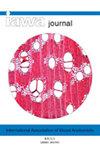Anatomical properties of Hibiscus macrophyllus and its mature wood development
IF 1.4
3区 农林科学
Q2 FORESTRY
引用次数: 2
Abstract
The Hibiscus macrophyllus tree is widely planted in Indonesia especially on Java Island. It has several advantages to be developed commercially as a community or plantation forest compared to the famous introduced species Falcataria moluccana and Anthocephalus spp., including faster growth, higher wood density, and better stem morphology (straighter, more rounded, and lesser branches). However, information about the basic properties of this wood grown in plantations is limited. This study aimed to investigate the anatomical properties of H. macrophyllus and their variation at three ages (8, 12 and 16 years old), as well as to predict the mature wood development by using radial variation in fiber length, microfibril angle (MFA), and wood density from pith toward the bark as the indicators. The wood samples were obtained from a community forest area at Ciamis Regency, West Java Province. Furthermore, anatomical characteristics were examined through wood slides following the IAWA List, while fibre and vessel element dimensions were measured through macerated specimens prepared by modified Franklin’s method. The MFA was determined by X-Ray Diffraction, while wood density was measured in line with British Standard 373-57. The results showed that the anatomical structures were not influenced by tree age, except for wood porosity, and fibre and vessel element dimensions. The 16-year-old tree tended to be semi-ring-porous, the younger trees were diffuse-porous, while the fiber and vessel element length, as well as the diameter, were decreased. Meanwhile, the wall thickness was increased. The fibre length, MFA, and wood density were useful indicators for wood maturity that seemed to be developed at about 11 years of age.木槿属植物的解剖特性及其成熟木材的发育
印尼特别是爪哇岛广泛种植木槿树。与著名的引种物种Falcotaria moluccana和Anthocephalus spp.相比,它有几个优势可以作为群落或人工林进行商业开发,包括生长更快、木材密度更高、树干形态更好(更直、更圆、枝条更少)。然而,关于种植园中生长的这种木材的基本特性的信息有限。本研究旨在研究大叶藻的解剖特性及其在三个年龄(8岁、12岁和16岁)的变化,并以纤维长度、微纤维角(MFA)和木材密度从髓向树皮的径向变化为指标来预测成熟木材的发育。木材样本取自西爪哇省Ciamis Regency的一个社区林区。此外,根据IAWA列表,通过木片检查解剖特征,同时通过改良Franklin方法制备的浸渍标本测量纤维和血管元件尺寸。MFA通过X射线衍射测定,而木材密度根据英国标准373-57测定。结果表明,除木材孔隙率、纤维和血管元件尺寸外,解剖结构不受树龄的影响。16岁的树木倾向于半环状多孔,较年轻的树木呈弥漫多孔,而纤维和血管元件的长度以及直径都有所减少。同时,壁厚增加。纤维长度、MFA和木材密度是衡量木材成熟度的有用指标,这些指标似乎是在11岁左右形成的。
本文章由计算机程序翻译,如有差异,请以英文原文为准。
求助全文
约1分钟内获得全文
求助全文
来源期刊

IAWA Journal
农林科学-林学
CiteScore
3.40
自引率
15.80%
发文量
26
审稿时长
>36 weeks
期刊介绍:
The IAWA Journal is the only international periodical fully devoted to structure, function, identification and utilisation of wood and bark in trees, shrubs, lianas, palms, bamboo and herbs. Many papers are of a multidisciplinary nature, linking
 求助内容:
求助内容: 应助结果提醒方式:
应助结果提醒方式:


